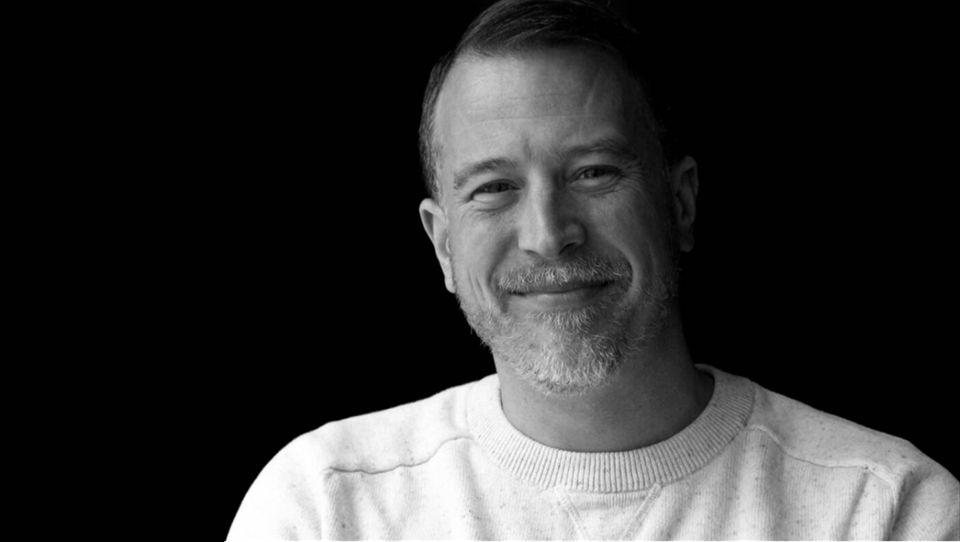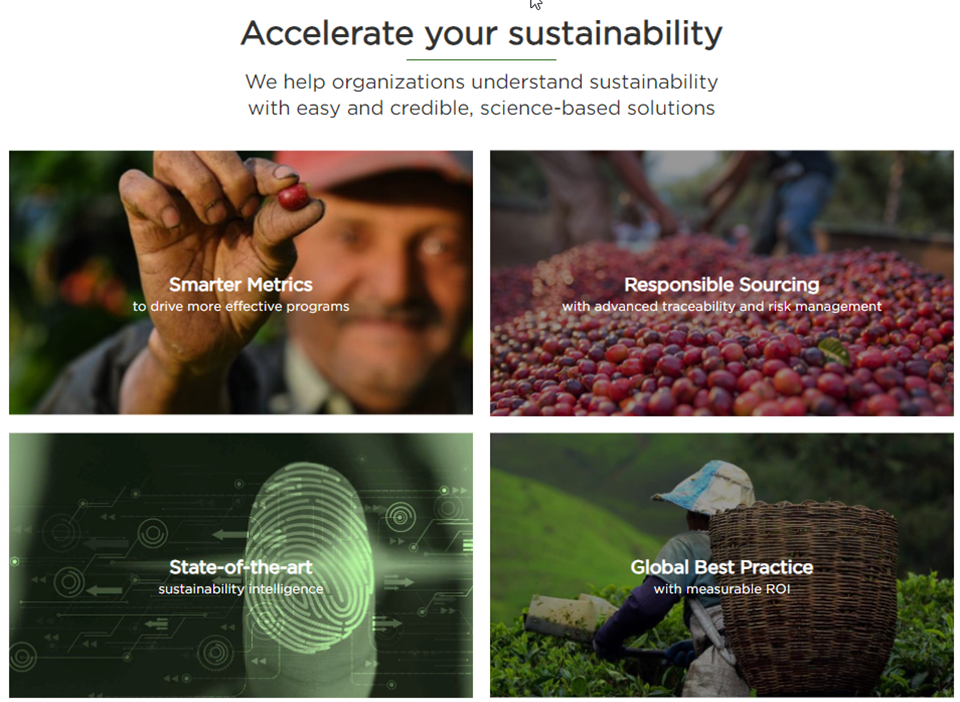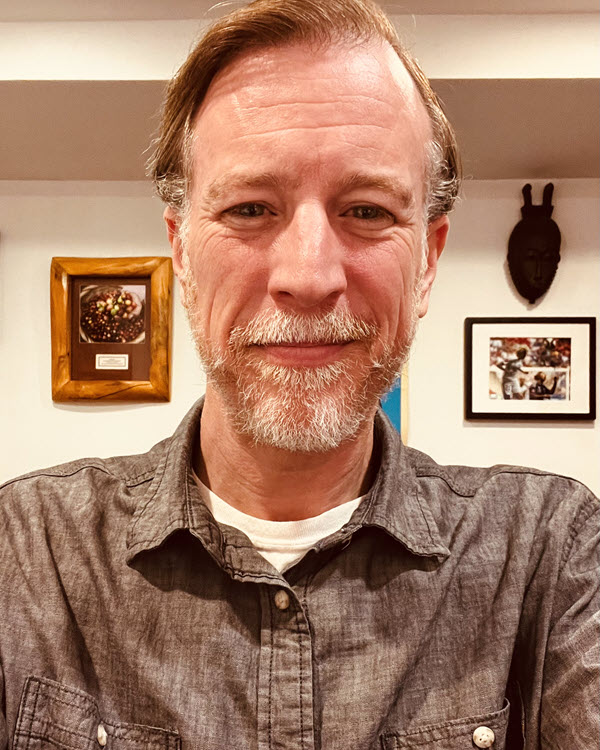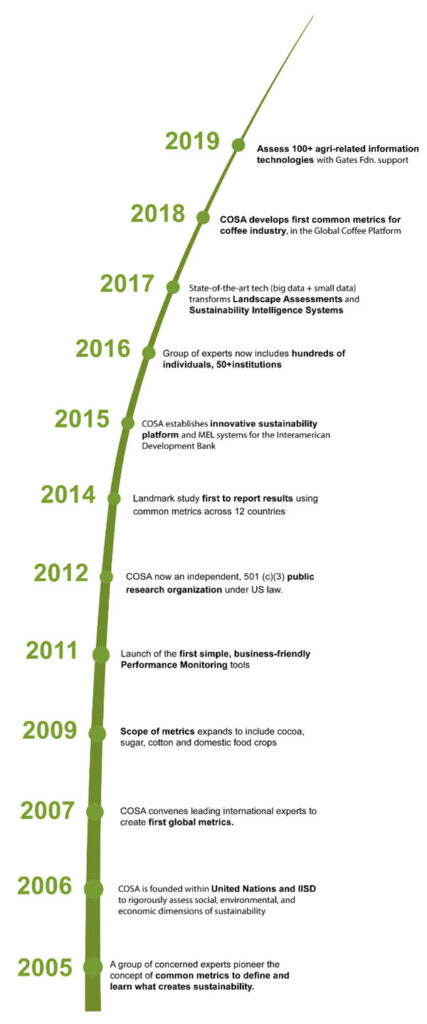Episode 155
The Committee on Sustainability Assessment (COSA) was established to measure the massive quantity of precise data and the impact of harder-to-quantify, pragmatic ways of measuring sustainability, such as living income calculations, gender inclusion, and next-generation training.
In 2005, sustainability pioneers at the United Nations identified the need to harmonize sustainability metrics with science-based credibility. Seven years later, COSA became a not-for-profit public research organization to complete that work.
Daniele Giovannucci co-founded COSA to counter what he called “the fluff and ignorance masquerading as development and the colossal sums wasted by well-meaning funders.” He championed the “democratization of data,” devising standard metrics for the coffee industry in 2018.
COSA, supported by discerning philanthropists from the Bill & Melinda Gates Foundation to the InterAmerican Development Bank, has standardized sustainability metrics for leading brands, global frameworks, cutting-edge technologies, and governments for two decades. Giovannucci retired in mid-2023, and Liam Brody was named his successor. Liam joins us on the Tea Biz Podcast to explain COSA’s role in intelligence-gathering and developing strategic tools that advance sustainable practices with “good business” underpinnings. He also shares his vision of how artificial intelligence will revolutionize and influence consumer behavior and perception of sustainable practices.

Predictability is Around the Corner
By Dan Bolton
COSA Board Chairman Richard Rogers, in announcing the promotion of Liam Brody to CEO, described him as the right leader to unlock the exponential impact of the organization. Brody “is an accomplished and visionary leader” who can drive the transformative change needed to help tackle today’s sustainability challenges.”
Liam was president of Sustainable Harvest, a trailblazing B Corporation and leading specialty coffee importer. As president, he doubled the company’s size, leading strategy and operations—overseeing sourcing, sales, finance, marketing, technology, talent, and impact. Liam spent nearly a decade with impact investing pioneer Root Capital, helping unlock $1 billion in finance for small and growing agricultural businesses around the globe. Earlier, Liam was director of sustainable coffee for Green Mountain Coffee (now Keurig Dr Pepper) and was a program manager, campaign director, and private sector adviser for the humanitarian organization Oxfam—where he played a crucial role in building the fair trade market.
He earned a Bachelor of Science in Agricultural Education from Cornell and holds a Master of Education in Social Policy from Harvard.
Dan Bolton: Congratulations on your appointment. It’s an outstanding choice on COSA’s part.
Liam Brody: Thank you, Dan! That means a lot coming from you. You’re one of my heroes in the tea and coffee community. I’ve learned so much from reading and traveling with you over the years. It’s a pleasure to be part of this conversation.
Dan: In just a sentence or two, will you tell readers what you will do now that you’ve got the reins in hand?
Liam: First and foremost, we plan to scale our work exponentially to help make a dent in two of the most pressing issues facing our world and the global food system: climate change and inequity. Over the next ten years, COSA will impact 100 million farmers stewarding a billion hectares of land.
Liam: But, to go forward, it might be helpful if we first look back. COSA started with a simple question: “What is sustainability, and how should it be measured?” As we began to answer those questions, we started advising tea, coffee, and chocolate professionals on how to use the best science and practice to actually measure. But that work only introduced more questions, like, “What do we do with all of this data once we’ve measured it and, most importantly, how do we make sense of it?”
Today, COSA finds itself helping all actors in a value chain, from tea and coffee to cocoa, palm, and more, use data to advance impact, performance, and risk reduction. Together, our work is transforming the global food and agriculture system to work and better benefit all involved—from crop to cup. We are working to climate-proof our future. And to do so in a way that is economically advantageous to all involved. That used to be “pie in the sky.” Now, with all that data, new tools, AI (artificial intelligence), machine learning, Earth Observation (geolocation and remoting sensing), predictive analytics, and more, it’s a reality knocking on our front door.
“It used to be that no matter how smart the human was in this equation, we just couldn’t process all this data ourselves. There were just too many variables.”
Liam Brody, CEO Committee on Sustainability Assessment
It used to be that no matter how smart the human was in this equation, we just couldn’t process all this data ourselves. There were just too many variables. You know, old school when the world changed at a slower pace and harvest seasons and global production were more consistent—forget the new variables coming at us at much higher, seemingly unpredictable velocity.
Today, new tools and approaches are changing the game from always being backward through the rear-view mirror to giving everyday tea professionals a new crystal ball that allows us to look around the corner and predict what’s coming. But, to harness this new power, we need good data and strong systems—and integrated tools designed for all players in the value chain. This allows us to play a granular game at scale—ultimately allowing us to invest in the right things at the right time to boost impact, performance, efficiency, deliverability, and more.
We are leading a multi-year effort with the Bill & Melinda Gates Foundation to use these new tools to lower the cost and time needed to collect data. No supply chain professional wants to spend all their time and money on measurement for the sake of measurement. We want to drive change. These new lean and agile approaches we are pioneering will help all of us spend the time and money saved on insights and investing in action. COSA is doing extensive published research to determine how to deploy technologies like WhatsApp, SMS, and satellite imaging to leapfrog outmoded approaches.
The game is finally shifting to real-time. That allows us to get ahead of problems before it’s too late. And everybody wins. If a farmer learns early in the season that she is at risk of crop failure—it’s a terrible realization. But, the sooner she knows, the sooner she can act. And, the sooner she knows, the sooner a buyer knows. An enlightened buyer might decide to help make a critical investment, or offer a multi-year deal to bridge the crisis—or even partner with the local government or a humanitarian organization on stopgap measures. As a former buyer and financier, being unable to predict potential defaults or delivery delays far enough in advance could be catastrophic to our business—let alone the positive impacts so many of us in tea seek to make in the world.

Dan: Alan Lai and his team at ProfilePrint in Singapore and Dr. William Ristenpart, who heads the Coffee Center at the University of California, Davis, have developed cloud-based apps to identify raw and finished leaves, seeds, and grains. IDaaS is an authentication service that uses desktop sensors, scanners, and even cell phones to upload “digital profiles” and, in seconds, download detailed chemical and physical attributes of the sample that reveal and quantify defects, colors, shape, the presence of adulterants, and other characteristics closely correlated to organoleptic qualities assigned by trained tasters.
Liam: Absolutely. Our ability to analyze where something went wrong in the process is key. Otherwise, too many people still assume what went wrong must have been at the start of the chain.
But, if we can isolate variables, we better understand the problem and where it may have originated, not for blame, but for better performance and risk management. I love the idea of shortening those feedback loops so you can quickly identify issues and rapidly give feedback, and frankly, you can quickly course-correct before something goes sideways.
Dan: You’re a 90-storefront grocer with 100,000 pounds of tea inside your warehouse. Place a sample into the ProfilePrint analyzer, and within five minutes, you learn that you’ve got four weeks to sell it before staling will force you to sell at a heavy discount.
.
Liam: Integrate that data into a model that starts to overlay origin data. Origin data that tracks yield, productivity, cost of product, living income, and geopolitical and climate risk. The correlations can be a roadmap for business growth—because then you are getting into predictability, which is super cool.
Dan: Oversupply of tea is widespread. It’s a cyclical problem that depresses prices over decades. Tea multinationals exerted control over supply because they owned plantations and factories and employed large workforces. Today’s markets are fragmented, and there will never be a one-size-fits-all tea. Sellers have unprecedented access to data, and those who monitor consumer preferences could order tea on demand. In specialty coffee, Starbucks and Nespresso set quality minimums, then vet (or train) growers to meet those standards, rewarding them with long-term contracts at premium prices – achieving balanced supply and demand for their markets.
Liam: That’s the future, but we need to stop silo’ing sustainability as if it were a standalone thing only good for glossy reports and storytelling. Sustainability data is core to business planning and performance.
If we’re collecting the right data at the right time, we can start to understand the correlations between sustainability investments and core business ROI. We can start to see how labor availability, diversity, water scarcity, and productivity fit together in real-time with pricing with market demand and consumer profile changes. When you have access to that data — and can be sure that it’s not what the computer scientists call dark data — data just sitting there on a shelf – but rather in the sophisticated digital system, then you can move quickly to provide insights for everyone in the industry, especially the farmers and growers holding up the foundation.
Measure What Matters
As you said at the beginning, we can all be part of starting to understand what investments to make and when to get that tea on demand, ultimately to the right market at the right price. And, when I say the right price—I mean for producers, too.
But to play in that space, you must figure out what you’re measuring. You have to have places to put that data, and you have to have systems that work to analyze and visualize and allow the value chain to participate. We also need to start driving these evidence-based insights back to farmers so they can make real-time, informed decisions about their own lives.
Right now, there’s not enough of that. In stark examples, we see that the companies that have been investing in data for years are now figuring out how to harness it and are leaping far beyond those that have ignored the need, assuming it was just another cost. New regulations are motivating a wave of new brands ready to take the plunge—but too many seem solely focused on compliance rather than the true power to unlock business performance. But don’t worry. You haven’t missed out if you have started or are trying to figure out where to start. That’s why organizations like COSA exist. We can be your guide. But to be clear, the window is closing fast, particularly as the world of sustainability rapidly shifts from voluntary standards to regulatory absolutes. We also know that consumer demand is increasingly predicated upon evidence. There’s excellent new McKinsey research backing that notion around brands making evidence-based claims. We also know climate change is changing everything from growing region suitability to yield curves, quality, and pest outbreaks. And we know what that will do, from forced migration to labor shortages and human rights impacts that follow.
If we don’t have data at the center, we don’t get to manage through that level of change and crisis in tea, coffee, cocoa, beef, palm, and more.
And to be clear, more regulation is soon coming to tea. We all know that it’s the next wave. Now it is the time to invest—not just for PR, although impact data and traceability lead to powerful authentic storytelling—for risk mitigation, resilience, and performance management.
In addition, we should be doing collaboratively as a sector, not just competitively, so we can compete on the things that matter. Then, we can put our collective money into investments for the future, not just backward-looking compliance.
Dan: Collecting rich data is essential to traceability, which is critical for credibility in marketing, right?
Liam: I couldn’t agree more. That’s where the curtain has been pulled back. There’s no more hiding. And that’s exciting. These are investments that need to be made in our future because if we’re not making them now, knowing what we know about population shifts, knowing what we know about climate, knowing what we understand about the geo-political risks, and what consumers are demanding, then brands, farmers, and entire industries will falter.
We must get around those corners. We must have scenarios that predict what’s coming. And if you’re not dealing with that or managing these issues using sound information systems or not learning in real-time, you’re missing out.
It’s plain and simple. There’s a place to play for people who want to learn.
That makes me so proud to be a part of an organization like COSA because we build bridges across governments, global brands, farmer organizations, and civil society to address that essential truth. We must know what we are solving for. How are we solving it? And how will we know if we’ve done it? The data speaks for itself. You can’t obscure it if you’re measuring the right things in the right way and embracing a commitment to continuous improvement–whether that’s financial performance for a value chain, social performance, environmental performance, or how those are all tied together. And so, for many of us, it is a new day, and I’m just so excited to be a part of it.
Photos courtesy of the Committee on Sustainability Assessment (COSA)
Powered by RedCircle
Share this post
Episode 155 | Liam Brody, the new Committee on Sustainability Assessment CEO, explains COSA’s role in intelligence-gathering and developing strategic tools that advance sustainable practices with “good business” underpinnings. He also shares his vision of how artificial intelligence will revolutionize and influence consumer behavior and perception of sustainable practices. | 16 Feb 2024



